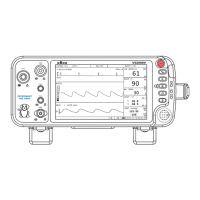Chapter 6: Alarms
Veterinary Vital Signs Monitor Operation Manual 6-1
Chapter 6: Alarms
6.1 Parameter Alarms and Technical Alarms
A parameter alarm occurs when a numeric measured value matches or
exceeds the high or low limit set for that parameter.
A technical alarm occurs when there is a malfunction with any of the sensors
or connections, or when the battery is low or when an error is detected during
self-test.
During an alarm, an audible alarm tone will sound and a message will be
displayed in the alarm status bar at the top of the display. For parameter
alarms, the violating measured value will flash.
6.2 High, Medium, and Low Priority Alarms
Caution! Only qualified doctors can set the physiological parameters’
upper limits for alarm level according to patient's conditions.
Alarms are categorized as high priority, medium priority, or low priority.
High Priority Alarms
A high priority alarm sound consists of two bursts of five single tones over a
four-second interval. The sequence is repeated every ten seconds. High
priority alarms supersede all other alarms. The alarm message will be
displayed in the alarm status bar with a red flashing background; the violating
measured value will flash in red.
CAUTION! When different priority alarms occur simultaneously, only the
highest priority alarm is displayed.
Medium Priority Alarms
A medium priority alarm sound consists of two bursts of three single tones
that repeats every 18 seconds. The alarm message will be displayed in the
alarm status bar with a yellow flashing background; the violating measured
value will flash in red.
Low Priority Alarms

